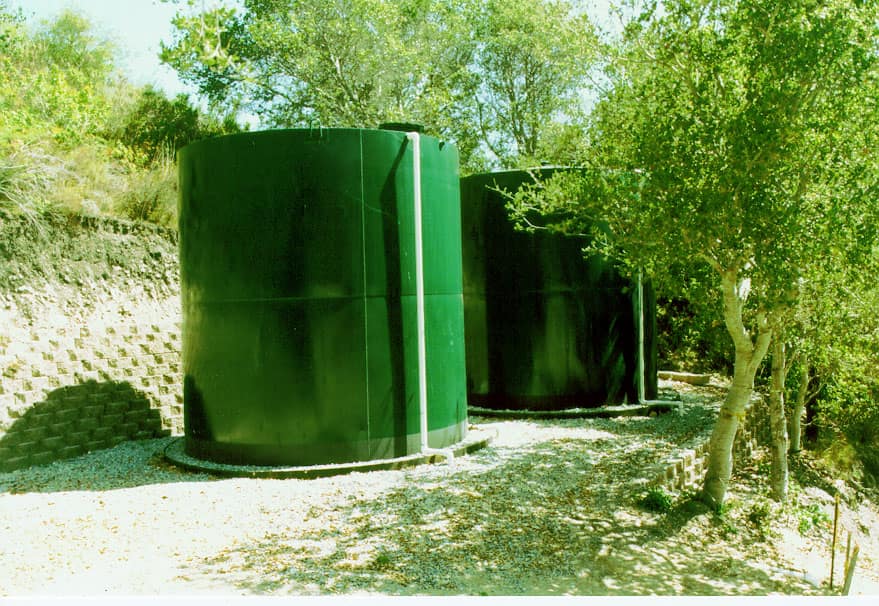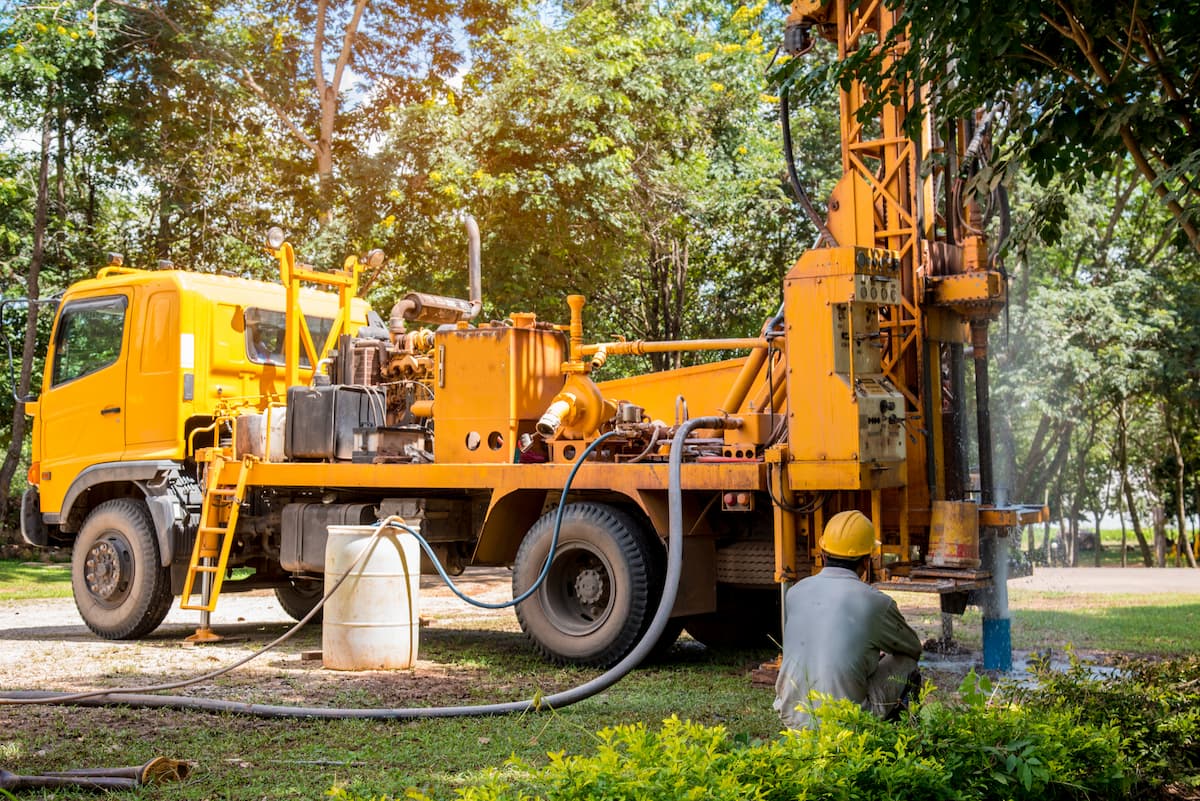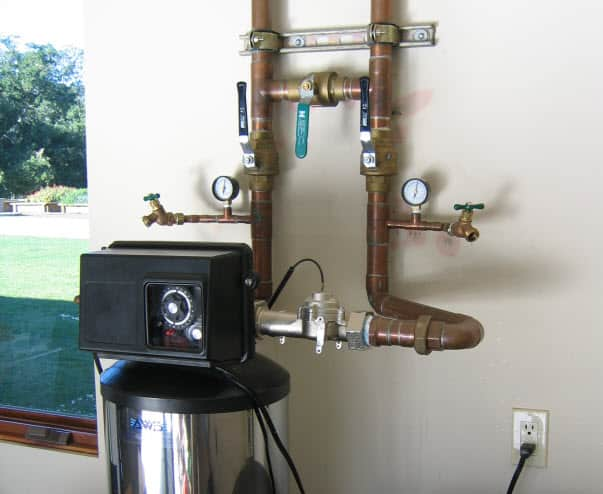No-Salt Softeners Versus Salt Water Softeners – Pros and Cons
Podcast: Play in new window | Download
Subscribe: RSS
In this Episode 9 of Clean Water Made Easy Podcast, our host and resource person, Gerry Bulfin, a water treatment contractor and WQA Certified Master Water Specialist explains the differences between traditional salt-based water softeners and no-salt water conditioners or softeners.
You will hear and learn about:
- What is a water softener and how are they used?
- About hard city water due to calcium carbonate and magnesium
- How traditional water softeners work.
- What is a no-salt water conditioners and how does it work?
- Under what water conditions do you not use a no-salt water conditioner?
- Signs that your water is already soft.
- Definition of hard water
- Advantages of having soft water
- What is a Template Assisted Crystallization (TAC)?
- What is a scale stopper?
- What is the role of the German Society of Gas & Water on the study of no-salt softeners?
- Why is the no-salt softener controversial?
- Does the no-salt conditioner actually remove the excess calcium in your water?
- Which one has a limited application, the salt or no-salt softener?
- Which of the 2 softeners has lower maintenance cost?
- What is capacitive deionization?
- Which type of softener does our host/resource person recommend?
After finding the explanation to the above questions, we hope that you will now consider the enigma of the salt and no-salt water softeners as solved. For further questions, our host can be reached at gerrybulfin@cleanwaterstore.
Related readings on no-salt water softeners.
FULL TRANSCRIPT
Episode 9: No Salt Versus Salt Water Softener Pros and Cons
You’re listening to the Clean Water Made Easy Podcast episode 9.
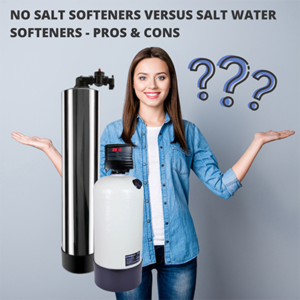
In this episode, I’m going to talk all about differences between water softeners and no salt water conditioners. Something we get a lot of questions about. Mainly I talk about well water & well water treatment systems on these episodes but today, this covers folks on city water as well. There is a lot of city water that’s hard because it’s high in calcium, magnesium and creates scale.
So we’re going to cover how traditional water softeners work and the types of no-salt water conditioners. Some people call them no- salt water softeners but we prefer to call them conditioners. We’re going to talk about when to use them, and more importantly under what conditions not to use a no salt water conditioner. There are some conditions where you would prefer a standard softener if you have hard water.
And if you want to go to the website it’s CleanWaterStore.com/blog/podcast and you can get more information about some links to one of the studies I talk about in this episode and you can see pictures and stuff so, if you want to check it out, go there and you will get more information.
Okay so, what about water softeners?
When would you use a water softener?
Well, really if you don’t need a water softener, you’ll probably know it. Your water is soft, meaning it’s not leaving white spots and stains on your shower heads, your dishes come out clean, and the water feels soft, which means that soap easily dissolves in it.
What is hard water?
If your water is hard, we consider water that’s hard over about 5 to 7 grains per gallon. Maybe some water softening salesman would say, the water is hard if it’s over 2 or 3 grains per gallon which is technically true, it has hardness in it but from our experience most people can live pretty good with water that’s less than 7-8, even 10 grains per gallon. Grains per gallon is a measurement of how you can test the water for hardness – how much by weight, how much calcium carbonate is in a gallon of water. For instance: 10 grains per gallon is pretty hard so it’d have a fair amount of calcium carbonate dissolved in it.
Benefits of Soft Water
So if you have less than 10 grains per gallon and you’re not seeing a problem, then don’t worry about it. But a lot of folks in the US, Canada and around the world of course, have very hard water. When it gets up above 8-10 grains per gallon and really 12, 14 & 15 grains per gallon, at that point it’s actually economically feasible to install a water softener or perhaps a no salt water conditioner because it saves you money. It won’t wear out your water heater, and it won't wear out your clothes by having excess mineral deposits build up in them in the laundry & dryer. It’s also an aesthetic issue because by having soft water, your hair is softer, your skin is softer, and you can use a lot less soap. So basically, you want to use a water softener when your water is hard.
What water softeners do
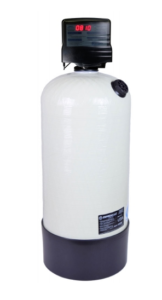
So traditional water softeners remove hardness scale physically from the water. So if you have hard water and you remove the hardness, then your dishes and fixtures will often be fairly spot-free, you won’t see that white deposits on them, your shower doors will be more spot-free and everything is so much easier to clean.
The laundry is brighter, you don’t have to use bleach as much and so there’s a lot of advantages to softeners. It extends the life of your appliances such as your dishwasher and your water heater. So people are often highly motivated to, if they have hard water, to get water softeners.
How a water softener works
So, the problem is that with a water softener, the way they work is they have resin beads in them. If you can imagine a tank, looks like an oxygen tank or a pressurized little tank, has resin beads in it and as water flows through the calcium or magnesium in the water is trapped by it sticking on the resin beads. In a process called ion exchange, a sodium ion is put into the water, so that’s where the salt comes in. Salt water softeners use salt and so the way they use salt is for every bit of calcium that is removed, they put an equal amount, sometimes a little more bit, of sodium back into the water.
So you got a situation where now, sodium doesn’t cause the same problem as the calcium scale does. You now have a situation where now your water is much cleaner. This process goes on in an automatic water softener and days go by, maybe a week goes by, and at some point, the resin beads are so saturated with calcium that this has to be cleaned. So the traditional automatic water softeners automatically cleans itself with brine, so you have a brine tank which holds the salt and cleans at the middle of the night when no one is using water. Typically, it sucks up some brine and cleans and regenerates the resin beads and washes all that calcium down the drain along with quite a bit of salt. So what happens is, is that your resin is good to go again to keep softening the water and they work great.
Impact of salt softener on wastewater stream
But, one problem is that the salt type of softener systems are putting brine, chlorides and sodium into the waste water. That can be a problem, for example in California, since a lot of areas are trained to recycle their waste water to use on golf courses, irrigation and industrial uses. It’s really a problem for them if there’s a high amount of sodium & chloride because it’s really expensive for them to take that out of the water vs. just cleaning up the water if there wasn’t an excess level.
And there’s a lot of other things bearing controversy and that’s a whole another long story. But as far as the legislation and the whole thinking behind it, is they think in some areas the softeners do have an impact on the waste stream so there’s been a lot of work – What can we do?, What are our alternatives to it?, and then just from an individual standpoint as consumers, it’s pretty neat to have totally soft water and a no-salt soft water system that you didn't have to do any maintenance to it. You didn’t have to add any salt and it didn't require any electricity. It’s kind of too good to be true, and in fact it is, as I’ll talk to you about it in a minute. But they do work and there are some benefits to it just to say that upfront, but you have to be careful under what conditions you’re using them and what your expectations are of a no-salt soft water system.
That’s again how water softeners work and they’re very effective. The new ones are more efficient than the old ones using salt. The new ones we use now have up-flow brining and use very little salt, they count how many gallons you’re using in the house and only do the regeneration process when it’s really necessary. So the new generation uses a lot less salt but they still use salt. So if you could use a no salt water conditioner and it did what you wanted it do then it sounds pretty good.
No-salt water softeners
Some sites like I said will call them no-salt water softeners but that’s kind of stretching the truth. We consider softening as removing the hardness from it, and in a no-salt water conditioner, you don’t remove anything from the water, the water going in is the same hardness as the water going out. The difference is that the actual water is treated so it doesn’t build up scale.
How no-salt water conditioners work
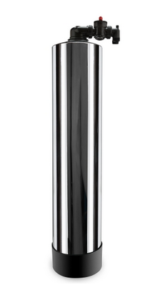
The way this works, at least in the common type that seems to work the best, uses a process called Template Assisted Crystallization (TAC). What that means is, there’s a template and you’ve got a type of a structure so when the minerals in the water run into this, it forms a type of crystal. They’re nano-sized crystals that remain in the water and they’re harmless.
Basically you’re kind of growing calcite crystals and these can’t form scale. They don't form that hard scale where you have to get heavy acid or some kind of special cleaner or rub it with a pumice stone in order to get it off. It’s very soft to the inside of the pipes, particularly, water heating pipes. Particularly when the water’s heated. So the scale stopper conditioners (that’s our brand: scale stopper), has beads that have nuclearization sides in them and basically the mineral particles bind themselves onto these beads and that’s where the crystallization process occurs. After the minerals turn into crystals, they’re released into the water. These are all done quickly and instantly as the water flows through this thing.
Also, they also look like a water softener. It’s a tank of resin, the waters is piped into your water supply, all the water coming into the house flows through this, and feeds the water heater and your cold water. This type of system has been thoroughly tested and debated. Of course the water softening industry is intensely opposed to it because one thing you can’t test to know that they’re working. There’s no test that you can test before and after that’s accepted. There is not a simple test kit that will tell you that your no-salt water conditioner is working so it’s very controversial. But after selling them for some years and trying different brands and different types, we are very careful about how we promote them and sell them. But people who get them, they are very happy with them and, the reason is, they’re not looking for their water to be soft. They don’t want soft water perhaps and they don’t care so much the spots on their shower doors.
What they’re looking for is they want to prevent the hard water scale from ruining the water heater, particularly the on-demand water heaters, or affecting the washing machine or the dishwasher. These no-salt water conditioners have been widely tested and one of the tests that they use is a German study or protocol, the DDGW. I won’t try to say what it actually stands for, the DDGW, but essentially the German Society Of Gas & Water Specialists or German Society of Gas and Water. It’s a W512, the standard under which they do these tests.
Tricky thing is, it’s very misleading. This is how I look at it, because it’s testing only for heat exchangers. So this standard that some people that are trying to oversell or promote the no-salt water softeners as being able to eliminate water softeners and it’s the best thing that ever happened. Set it and forget it. Never needs maintenance, you know, more propaganda. But they essentially use this German standard as, “Hey, our products have been certified” but the thing is that it’s been tested for heat exchangers, in other words, for hot water applications.
Advantages and disadvantages of no-salt
Indeed, the standard that they tested for is, I think it’s like 70 or 80 degrees centigrade, just hot water. They’re using it for very hot water and so in cold water, it’s perhaps not as effective. It’s not really designed for cold water but on the other hand you can say, I don’t really have much of a problem with scale building up on my cold water.
But one thing that you can know that it’s not for spots or after the water’s evaporated. Like for instance, a lot of folks say, “Hey, I have hard water when this water evaporates on my ceramic tiles, in my bath tub or in the bathroom. I hate it cause it’s all white and it’s hard to get off” Well, the no-salt water conditioners don’t work for that, that’s at least how we promote it. We do have some customers that say they do see some effect on it, but it’s primarily for water heaters, to protect your pipes and to eliminate the scale inside the pipes. It doesn’t descale your existing pipes, although you could run citric acid and there’s a few other things you could try to kind of clean up your pipes if you have hard water already. But it will prevent scale from building up in the pipes and that’s why we call it the scale stopper.
We don’t call it the salt-free water softener but it basically stops scale. So that’s what we promote them for and you know, we guarantee folks are happy and we do get some returns. Not many but we have had people say, I thought I was getting a water softener. We try to tell folks upfront, it’s not a water softener. Indeed, if you have super hard water, say you have 20-25 grains per gallon, and you’ve been living with a water softener for many years and you’re sick of dealing with the salt or you just don’t want to get another water softener for some reason, you wouldn’t be happy with a no-salt water conditioner is my prediction.
The water will feel hard cause it is hard. It might not build up in the pipes but it will still have a problem with hardness and if the water evaporates, you’ll still see hardness in the water, you’ll still see that calcium.
One question guys, How do I know which type to use? I’m confused now, sounds good to me, I think I do want a no salt softener, I mean who wouldn’t want to have soft water with no maintenance. First, you have to test your water for hardness, if your water has high hardness, say 12-15 grains per gallon I probably would recommend a water softener unless you really don’t care about then spotting on the shower doors or you know, in the dish washer.
Template Assisted Crystallization Systems
The Template Assisted Crystallization Systems, the no-salt water conditioner, are good up to 50 grains per gallon but you still will have to live with 50 grain per gallon water. If you have 50 grains per gallon, the water’s going to feel hard. There are some folks in some areas where they won’t let you put in a water softener in which case, your only option is to rent an exchange tank water softener or they come and take it away somewhere else in a different area and regenerate it. Or you can get one of these no-salt conditioners which are pretty good.
People are very happy with them. They have the right expectation about what they’re getting and they’re looking for lower maintenance and particularly, no problems with scale build up in the pipes. Another thing that comes up a lot with these systems, is the whole maintenance and in fact, the resin does need to be changed sometimes every few years.
We’ve heard they last as long as 4-5 years but the idea that the resin in the no-salt water conditioners will last for many, many years or that you get a lifetime warranty is silly. All the different studies and our experience with many customers is that, after a few years, you need to pour out the resin and it’s not that hard to do, but that’s the maintenance. There’s no back washing, there’s no electricity involved, and there’s no waste water but you do have to change the TAC resin every so often. and You will know when it’s time to change it because you’ll start to see problems with the scale build up again.
So anyway, I hope that answered a lot of your questions about that and if you do have any questions, feel free to shoot me an e-mail, my e-mail is gerrybulfin@cleanwaterstore.com and if you want to go to the site, you’ll get a lot more information on this and it is written like a blog post about this. As well as links to the Arizona state study in 2013 with an Engineer and a Professor from AZ stat,e and they’re working with this Water Reuse Research Foundation, where they want to reuse the water so they’re looking for other alternatives to softening.
Study done by the Water Research Foundation
So the Water Reuse Research Foundation did this pretty thorough study in studying heat exchangers again using DDGW standard. They ran the hot water, I think like 20 hours, through these heat exchangers. It was pretty amazing and they showed what worked and what didn’t. The type of resin that we use worked the best, it worked better than the other type of no- salt or in other words, they call it physical water conditioners or physical water treatment, as opposed to chemical water treatment. So the salt water softeners, some people use phosphates in water to help soften water, are all chemical water softening, depends on how they’d refer to it. But physical water treatment tries to make the calcium and magnesium turn into crystals that then don’t stick to the pipes. They go into the chemistry of it that you can read more about it. It’s very interesting but their study was very thorough and they basically show how the couple of other kinds of physical water conditioners or no-salt water conditioners didn’t work that well, and it wasn’t a big surprise to us because when we tried them they didn’t work that well either.
There’s some where there is a wire you wrap around the pipe and you plug it in. Those are really cool because there’s no installation requirements, you just you wrap it around, plug it in and you can install within minutes. They work very minimally so, people didn’t notice much of a difference at all with them. They still have problems with water heaters, or that type of thing, but again, it depends on the water chemistry and depends on the situation but that was our experience. They might work for some people, but I’m not completely experienced with those. But a few who’ve tried people weren't very happy with them. That’s’ the electrical one.
There’s the resin one which is the kind that we use. It’s a TAC and we call it scale stopper, and that was the exact same resin used in their study. We didn’t pay them to do it, we just happen to use the same technology. Then the other of the three types that they’ve studied actually physically removes the hardness of the water, but it uses waste water and about 25% of the water is wasted. They’re quite expensive and they haven’t been commercialized well, they’re called the capacitive de-ionization. Essentially, these are carbon aerogel material and they put a anode-cathode on it and run some electricity through it. This attracts the hardness so it’s physically taking the hardness out of the water as well as some minerals too. But they’re quite expensive, they’re not really practical as far as what we can tell, they’re 4-5x , sometimes 8-10x, more expensive than a softener or a no-salt conditioner that I’ve been talking about.
If you have any more questions or if you want to find out more about the no-salt water conditioners just visit our site: CleanWaterStore.com and if you want to read this podcast or get the links on it, go to CleanWaterStore.com/blog/podcast and you’ll see this in episode 9.
Oh, don’t forget to hop over to iTunes and leave us a nice review. When you're subscribed to our podcast you'll be notified every time we release a new show. Thanks again.
Also read:
Understanding Grains Per Gallon Hardness


